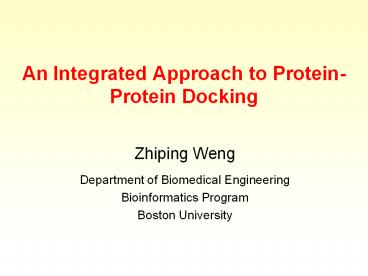An Integrated Approach to Protein-Protein Docking - PowerPoint PPT Presentation
Title:
An Integrated Approach to Protein-Protein Docking
Description:
An Integrated Approach to Protein-Protein Docking Zhiping Weng Department of Biomedical Engineering Bioinformatics Program Boston University What is Protein Docking? – PowerPoint PPT presentation
Number of Views:188
Avg rating:3.0/5.0
Title: An Integrated Approach to Protein-Protein Docking
1
An Integrated Approach to Protein-Protein Docking
- Zhiping Weng
- Department of Biomedical Engineering
- Bioinformatics Program
- Boston University
2
What is Protein Docking?
Protein docking is the computational
determination of protein complex structure from
individual protein structures.
3
Motivation
- Biological activity depends on the specific
recognition of proteins. - Understand protein interaction networks in a cell
- Yield insight to thermodynamics of molecular
recognition - The experimental determination of protein-protein
complex structures remains difficult.
4
Ubiquitination
5
Experimental Tools for Studying Protein-Protein
Interactions
- 3-D structures of protein-protein complexes
X-ray crystallography NMR - Binding affinity between two proteins SPR,
titration assays - Mutagenesis and its affect on binding
- Yeast 2-hybrid system
- Protein Chips?
6
Computational Tools for Studying Protein-Protein
Interactions
- Protein docking
- Binding affinity calculation
- Analysis of site-specific mutation experiments
- Protein design
- The kinetics of protein-protein interactions
7
Protein-Protein Interaction Thermodynamics
8
The Lowest Binding Free Energy DG
water
9
General Derivations
10
Two kinds of docking problems
- Bound docking
- The complex structure is known. The receptor and
the ligand in the complex are pulled apart and
reassembled. - Unbound docking
- Individually determined protein structures are
used.
11
Challenges
- Large search space
- Imperfect understanding of thermodynamics
- Protein flexibility
- Heterogeneities in protein interactions
12
Divide and Conquer
- Initial stage of unbound docking
- Assume minimum binding site information
- Try to predict as many near-native structures
(hits) as possible in the top 1000, for as many
complexes as possible - Post-processing
- Re-rank the 1000 structures in order to pick out
near-native structures
13
Energy Components
14
An Effective Binding Free Energy Function
Number of atoms of type i Desolvation energy for
an atom of type i
15
Fast Fourier Transform
Increase the speed by 107
16
DOCK by Kuntz et al.
17
Evaluate Performance
- Gold Standard Crystal structure of the complex
- A near-native structure (hit) RMSD of Ca after
superposition lt 2.5 Å - Success rate Given some number of predictions,
percentage of complexes with at least one hit
18
Docking Benchmark
55 non-redundant complexes http//zlab.bu.edu/ron
g/dock/
19
(No Transcript)
20
Post-Processing Using RDOCK
21
CAPRI Results
Target Total Contacts Top Predictions Our Prediction
1 52 17 (1st) 5
2 52 27 (2nd) 50 (1st)
3 62 45 (1st), 43 (2nd) 37 (3rd)
4 58 1 (1st) 0
5 64 10 (1st) 4 (2nd)
6 65 60(1st) 18
7 37 30(2nd,3rd), 29(4th,5th) 31(1st)
22
Target 2 Antibody/VP6 Red Crystal
Structure Blue Prediction 50/52 1st
23
Target 7 T Cell Receptor / Toxin Red Crystal
Structure Blue Prediction 31/37, 1st
24
Target 3 Antibody/Hemagglutinin Red Crystal
Structure Blue Prediction 37/62, 3rd
25
Target 6 Camelide Antibody/a amylase Red
Crystal Structure Blue Prediction 18/65
26
Target 1Hpr/HPrK Red Crystal Structure Blue
Prediction 5/52
27
Summary
- Conformational change tolerant target functions
are needed for unbound docking - We need to balance shape complementarity,
desolvation, electrostatics components - If we submit 10 predictions, we have a 60
success rate.
28
Future Work
- An automatic protein-protein docking server
- Large scale comparison of all docking algorithms
on the benchmark - Post processing with binding site information,
conformation space search, clustering and
detailed free energy calculation - Make predictions!































